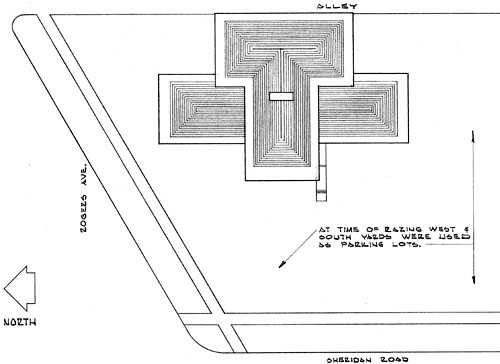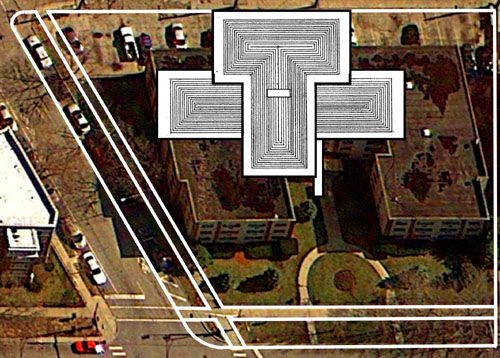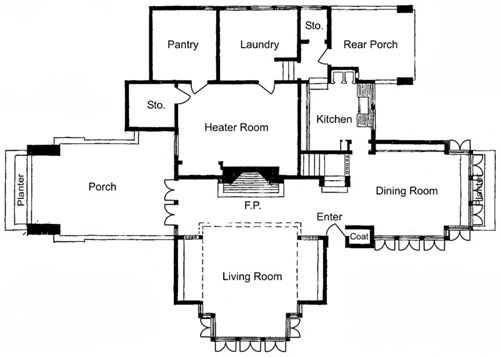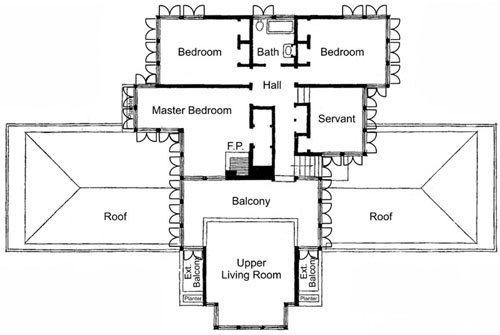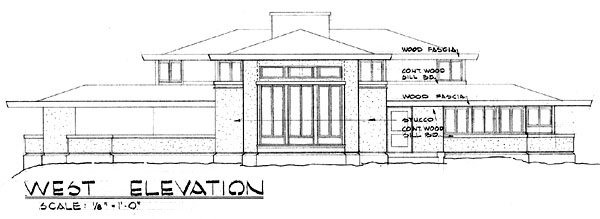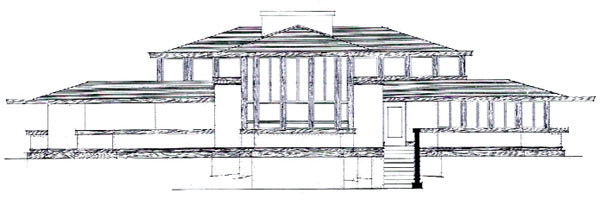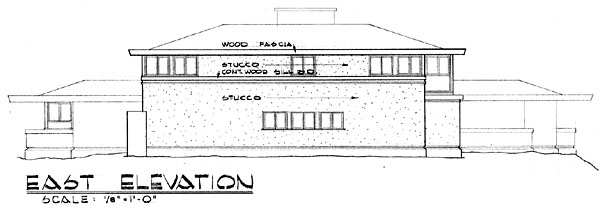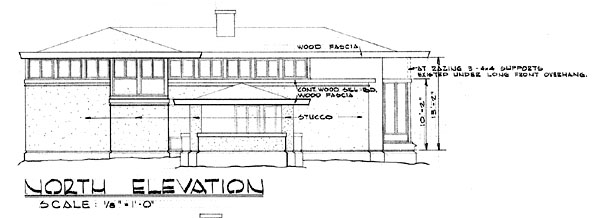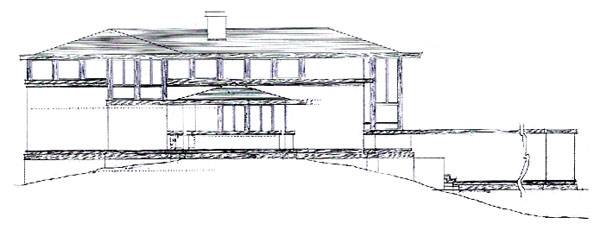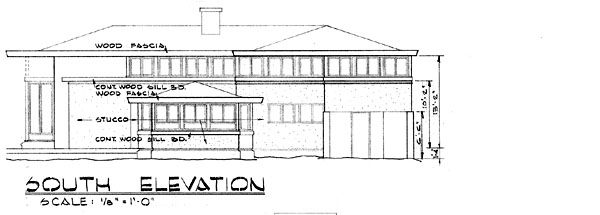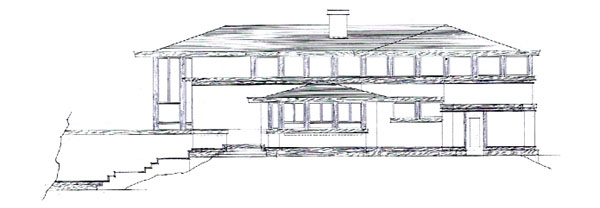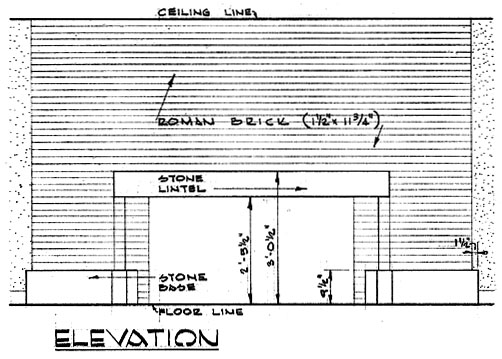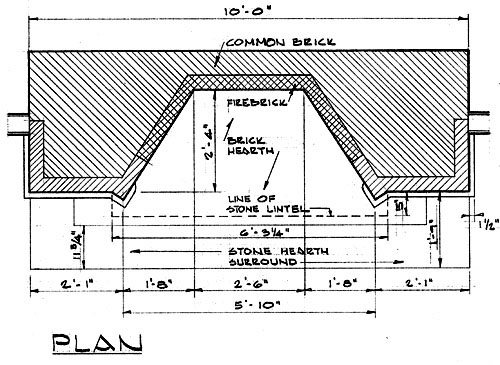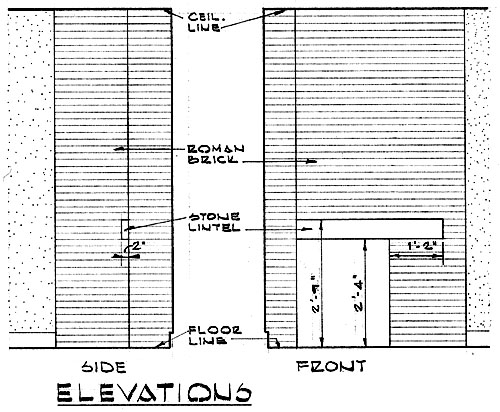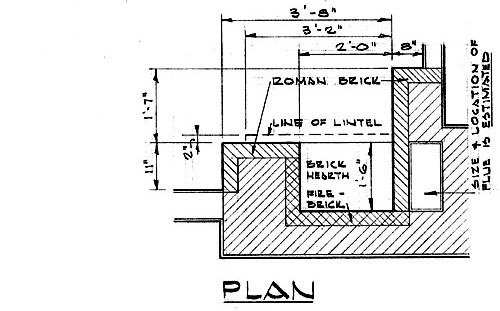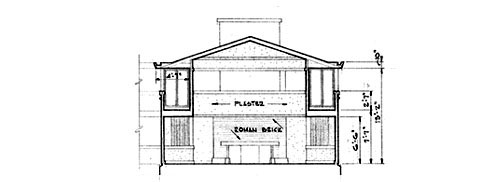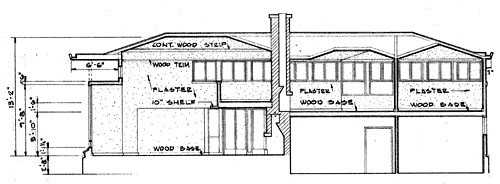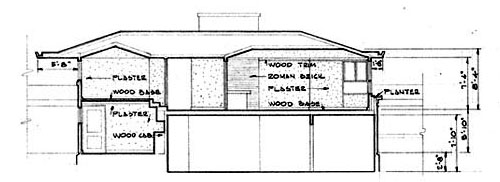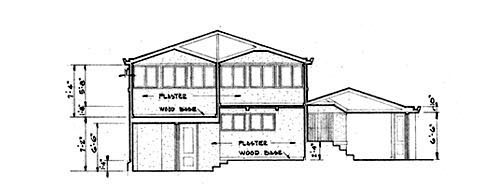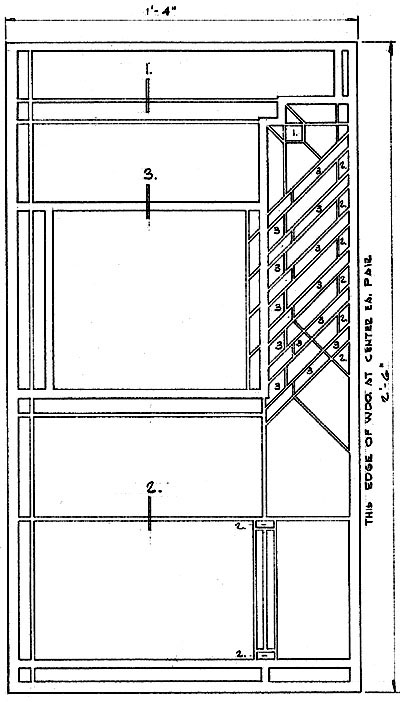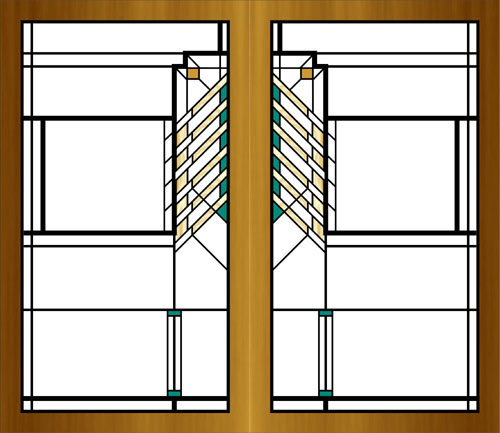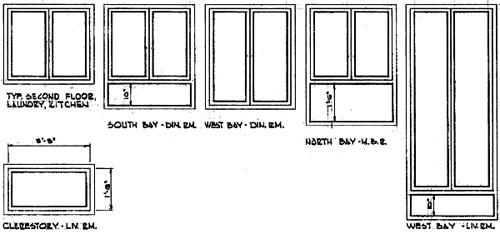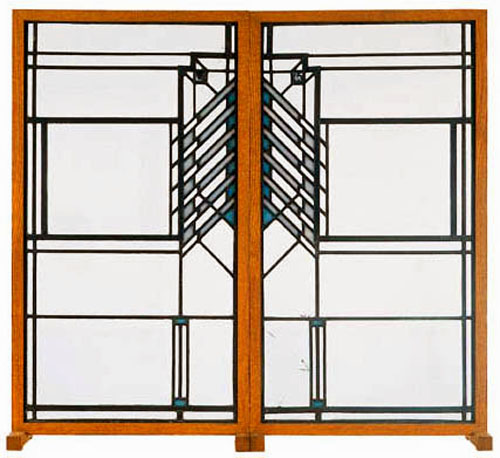- Wright Studies
Oscar M. and Katherine B. Steffens Residence, Chicago (1909 - S.153)
HABS: Historic American Buildings Survey 1963 Site Plan (Sheet 1) Floor Plan Elevations (Sheet 4) Fireplaces (Sheet 2 & 3) Cross Sections (Sheet 5) Windows (Sheet 6)
In April 1963, just before the destruction of the Steffens Residence, architects R. Gardner and J. William Rudd recorded precise measurements for the National Park Service. These drawings, completed on April 4, 1964, along with the written description completed in September 1966, leave an invaluable record of the Oscar Steffens Residence. Included are six sheets of measured drawings and a five page report. Located on the Southeast corner of Sheridan Road and Rogers Avenue, the home was set back against the alley, allowing a larger front and side yard. Being built on the top of a "ridge", the highest point on the lot, also offered expansive views of Lake Michigan from the upper Bedroom windows until apartments blocked the view. The Lake was only half a block away.
1) Sheet 1, Site Plan 1963. The lot was located on the Southeast corner of Sheridan Road and Rogers Avenue. Set back against the alley, this offered a larger front and side yard. Being built on the top of a "ridge", the highest point on the lot, also offered expansive views of Lake Michigan from the upper Bedroom windows until apartments blocked the view. The Lake was only half a block away. Courtesy of the National Park Service. 1A) Site Plan superimposed over an areal view of the lot in 2012. The lot was located on the Southeast corner of Sheridan Road and Rogers Avenue. Set back against the alley, this offered a larger front and side yard. A large apartment complex now occupies the space of the original single family Steffens Residents. Rogers Avenue was widened to accommodate parking on the street. Image courtesy of the Google Maps. Floor plan for the First level. The Living Room windows were originally designed to run from floor to ceiling, but alterations created a bay, with the top lining up with the base of the upper clerestory windows. Spindled screens on either side of the Living Room added a measure of privacy. The exterior balcony lowered the ceiling on either side, creating a space with a space. With built-in seating, this feature is reminiscent of the Usonian Living Rooms Wright designed decades later. From the corner of Sheridan and Rogers, the entrance to the home was hidden. Upon entering the home when you turned left (North) and walked past the Living Room and centralized Fireplace, a double set of doors lead out to an enclosed covered porch, with a built-in Planter. The stairs across from the Entrance lead to the second floor. To the right (South) was the Dining Room. A spindled screens enclosed the stairway, adding a sense of privacy. As you pass through the Dining Room, you enter the Kitchen. Passing through the Kitchen allowed access to the utility rooms and the enclosed rear Porch. Stairs lead down to the Rear Porch, and additional stairs to the Utility rooms which were located behind the Fireplace. By lowering these rooms on the first floor, this allowed the roofline of the bedrooms upstairs to line up with the Living Room roof which was only a story and a half. Courtesy of "Frank Lloyd Wright, Ausgeführte Bauten (Executed Buildings)", 1911. Modified by Douglas M. Steiner, copyright 2012. Floor plan for the Second level. As you reach the top of the stairs, turn left and you enter the Balcony which overlooks the Living Room. On either side of the balcony, doors lead out to an exterior Balcony with built-in Planters. Bedrooms and the Bath were reached by turning right at the top of the stairs. A row of art glass clerestory windows were recessed just beneath the roof line. Courtesy of "Frank Lloyd Wright, Ausgeführte Bauten (Executed Buildings)", 1911. Modified by Douglas M. Steiner, copyright 2012.
Comparing Wright's original elevations to the 1963 HABS allows us the opportunity to see alterations, many of which were completed during construction. It also gives details of finished construction materials, trim details, roof overhangs and windows sizes for all four sides. The Design of the Master Bedroom bay, hidden from view in existing photographs is exposed in these views. 4A) Sheet 4, West Elevation 1963. Lower Level: The covered Porch is on the far left, the Living Room in the center, the entrance just to the right, and the Dining Room is on the far right. Upper Level: The Master Bedroom is on the far left, the upper portion of the Living Room is in the center, with an exterior balcony on either side. A set of doors on either side lead from the interior Balcony to the exterior Balcony. The Bedrooms are on the far right. The Living Room windows were originally designed to run from floor to ceiling (see below), but alterations created a bay, with the top lining up with the base of the upper clerestory windows. Other alterations included reducing the number of windows on the upper level and narrowing the fireplace chimney. Courtesy of the National Park Service. 4A2) Wright's original drawing of the West Elevation. Lower Level: The covered Porch is on the far left, the Living Room in the center, the entrance just to the right, and the Dining Room is on the far right. Upper Level: The Master Bedroom is on the far left, the upper portion of the Living Room is in the center, with an exterior balcony on either side. A set of doors on either side lead from the interior Balcony to the exterior Balcony. The Bedrooms are on the far right. The Living Room windows were originally designed to run from floor to ceiling, but alterations created a bay (see 4A), with the top lining up with the base of the upper clerestory windows. Other alterations included reducing the number of windows on the upper level and narrowing the fireplace chimney. Courtesy of the Frank Lloyd Wright Foundation. 4B) Sheet 4, East Elevation 1963. Lower Level: The Dining Room is on the far left. The enclosed rear Porch and Utility and Storage Rooms are in the center, and the covered Porch is on the far right. Upper Level: Bedroom are on the left and right, with the Bath in the center. The Master Bedroom is on the far right. The number of windows on the upper and lower levels were reduced dramatically. Courtesy of the National Park Service. 4B2) Wright's original drawing of the East Elevation. Lower Level: The Dining Room is on the far left. The enclosed rear Porch and Utility and Storage Rooms are in the center, and the covered Porch is on the far right. Upper Level: Bedroom are on the left and right, with the Bath in the center. The Master Bedroom is on the far right. Wright designed he upper level with a row of clerestory windows that ran the full length from North to South. He also included more windows on the lower level. Courtesy of the Frank Lloyd Wright Foundation. 4C) Sheet 4, North Elevation 1963. Lower Level: The Utility and Storage Rooms are on the far left. The covered Porch is in the center, the Living Room is on the right. Upper Level: One of the Bedrooms is on the far left. The larger windows are part of the Master Bedroom as are the next two sets of smaller windows to the right. The last three sets of windows above the covered Porch are for the Living Room Balcony. To the right is the exterior Balcony and the Living Room Bay. The Living Room windows were originally designed to run from floor to ceiling (see below), but alterations created a bay, with the top lining up with the base of the upper clerestory windows. Courtesy of the National Park Service. 4C2) Wright's original drawing of the North Elevation. The home was built on the top of a "ridge", the highest point on the lot. Wright's original drawing highlights this "ridge". Lower Level: The Utility and Storage Rooms are on the far left. The covered Porch is in the center, the Living Room is on the right. Upper Level: One of the Bedrooms is on the far left. The larger windows are part of the Master Bedroom as are the next two sets of smaller windows to the right. The last three sets of windows above the covered Porch are for the Living Room Balcony. To the right is the exterior Balcony and the Living Room Bay. The Living Room windows were originally designed to run from floor to ceiling (see 4C), but alterations created a bay, with the top lining up with the base of the upper clerestory windows. Courtesy of the Frank Lloyd Wright Foundation. 4D) Sheet 4, South Elevation 1963. Lower Level: The Living Room and Entrance are on the left, the Dining Room is in the center, the Kitchen is to the right, and the enclosed rear Porch is on the far right. The door to the rear Porch gave access to the home from the alley. Upper Level: The exterior Balcony is on the left. The Living Room Balcony is above the Dining Room. Bedrooms are to the right. The Living Room windows were originally designed to run from floor to ceiling (see below), but alterations created a bay, with the top lining up with the base of the upper clerestory windows. Courtesy of the National Park Service. 4D2) Wright's original drawing of the North Elevation. Lower Level: The Living Room and Entrance are on the left, the Dining Room is in the center, the Kitchen is to the right, and the enclosed rear Porch is on the far right. The door to the rear Porch gave access to the home from the alley. Upper Level: The exterior Balcony is on the left. The Living Room Balcony is above the Dining Room. Bedrooms are to the right. The Living Room windows were originally designed to run from floor to ceiling (see 4D), but alterations created a bay, with the top lining up with the base of the upper clerestory windows. Courtesy of the Frank Lloyd Wright Foundation.
Fireplaces (Sheets 2-3) There were two fireplaces in the Steffens Residence. The large centralized Living Room Fireplace was similar in design to the Meyer May (1908 - S.148), Davidson (1908 - S.149), Roberts (1908 - S.150), Frank Baker (1909 - S.151) and many others designed during that time period with slight variations. The second was a corner Fireplace in the Master Bedroom. Both were faced in Roman Brick and like most of Wright's brickwork, more than likely the horizontal lines were racked, while the vertical lines were flush. Both fireplace had matching horizontal stone lintels, while only the Living Room Fireplace had a stone base. 2) Sheet 2, Living Room Fireplace Elevation. The large centralized Living Room Fireplace was similar in design to the Meyer May (1908 - S.148), Davidson (1908 - S.149), Roberts (1908 - S.150), Frank Baker (1909 - S.151) and many others designed during that time period with slight variations. It was faced in Roman Brick and like most of Wright's brickwork, more than likely the horizontal lines were racked, while the vertical lines were flush. Both fireplace had matching horizontal stone lintels, while only the Living Room Fireplace had a stone base. Courtesy of the National Park Service. 2A) Sheet 2, Living Room Fireplace Floor Plan. The face of the Fireplace was 10' wide by 6' - 6" tall. The stone lintel was 6' - 3.25" wide and 3' - .5" from floor to the top of the lintel. 3) Sheet 3, Master Bedroom Fireplace Elevation. The Master Bedroom Fireplace was in the Southwest corner. Both were faced in Roman Brick and like most of Wright's brickwork, more than likely the horizontal lines were racked, while the vertical lines were flush. Both fireplace had matching horizontal stone lintels, while only the Living Room Fireplace had a stone base. Courtesy of the National Park Service. 3A) Sheet 3, Master Bedroom Fireplace Floor Plan. The West face of the Fireplace was 4' - 4" wide, the South face was 2' - 6" and overall was 7' - 4" tall. The stone lintel was 3' - 2" wide and 2' - 9" from floor to the top of the lintel.
Cross Sections (Sheet 5)
Cross sections give us the opportunity to look inside the home Frank Lloyd Wright designed for the Steffens. Art glass windows, prairie styled spindle screens, vaulted ceilings, details that would have been lost forever.
5A) Sheet 5, Cross Section (at the back of the Living Room). Lower Level: The covered Porch is on the far left. The ceiling is vaulted and varies from 7' - 4" to 9' - 3". The roof cantilevers 4' - 11' over the built-in Planter. The railing height is 2.5'. It measures 24' - 5" long by 14' - 9" wide. The Living Room is in the center. The ceiling is vaulted. The height under the balcony is 6.5' high and opens to 16' - 11" at the peak. It measures 25' - 3.5" long by 23' - 6" wide. The stairs just to the right lead to the second level. The Dining Room is on the right. The door leads to the Kitchen. The ceiling is vaulted and starts at 6' - 6" to 9' - 3" high. It measures 19' - 2" long by 15' - 6" wide. Upper Level: The Master Bedroom is on the far left, the upper portion of the Living Room is in the center, the bedrooms are on the right. Courtesy of the National Park Service. 5B) Sheet 5, Cross Section (at the front of the Living Room Balcony). Lower Level: The Living Room ceiling is vaulted in the center. The height under the balcony is 6.5' high and opens to 16' 11" at the center peak. It measures 25' - 3.5" long by 23' - 6" wide. Spindled screens are visible on either side of the Living Room. Upper Level: The Balcony wall is 2' - 7" tall. Double sets of doors lead to the outside Balconies on either side. But the exterior Balconies were not very functional. They were only 5' - 7" tall. 5C) Sheet 5, Cross Section (West end of the Living Room). Lower Level: The Living Room ceiling is vaulted in the center. The height under the exterior balcony is 6.5' high and opens to 16' - 11" at the center peak. It measures 25' - 3.5" long by 23' - 6" wide. Upper Level: The exterior Balcony wall is 2' - 7" tall. But height of the exterior Balcony ceilings were only 5' - 7" tall. 5D) Sheet 5, Cross Section (at the center of the Living Room). Lower Level: The Living Room Bay is on the far left. The ceiling is vaulted. The height under the balcony is 6.5' high and opens to 16' - 11" at the peak. It measures 25' - 3.5" long by 23' - 6" wide. On the right side of the Living Room, two sets of double doors lead out to the covered Porch. The utility rooms on the right were lowered 2' - 8", allowing the roofline of the bedrooms upstairs to line up with the Living Room roof. Upper Level: The Living Room roof cantilevers over the Bay 6' - 6". Two Bedrooms are on the right. The left is the Master Bedroom. It is "L" shaped. The left side is 12' long, the right is 19' - 4" by 15' - 6". The ceiling is vaulted and is 7' - 4" to 8' - 4" at the highest point. The Northeast Bedroom on the right is 13' - 1" long by 11' - 7" wide. The ceiling is vaulted and is 7' - 4" to 8' - 9" at the highest point. 5E) Sheet 5, Cross Section (Through the lower Kitchen and the doorway of the upper Master Bedroom). Lower Level: The Kitchen is on the left, the height was 7' - 3". The doorway leads to the Dining Room. The Utility Rooms, Heater and Storage are in the center and right. The height was 7' - 10". The utility rooms were lowered 2' - 8", allowing the roofline of the bedrooms upstairs to line up with the Living Room roof. Upper Level: Three stairs lead up to the Servant's Bedroom on the left. The ceiling is vaulted and rises from 5' - 8" to 7 - 1". The opening to the right leads to the Living Room balcony. The stairs leading downstairs (not shown) are just to the left of the opening behind the Servant's Room. The Master Bedroom is on the right. The Fireplace is to the left, a built-in Planter outside on the right. It is "L" shaped. The far side is 12' long, the near is 19' - 4" by 15' - 6". The ceiling is vaulted and is 7' - 4" to 8' - 4" at the highest point. 5F) Sheet 5, Cross Section (Through the Kitchen and Dining Room looking South). Lower Level: The enclosed rear Porch is on the left. The leads out at ground level and gives easy access to the alley behind the home. The height of the ceiling is 6' - 6". Stairs lead up to the Kitchen in the center. Two sets of windows look South. Two exposed beams run North to South. The height of the ceiling is 7' - 3". The Dining Room is on the right. The stairs lead to the second level, with a spindled screen enclosing the stairway landing, adding privacy to the Dining Room. The ceiling is vaulted and starts at 6' - 6" to 9 - 3" high. It measures 19' - 2" long by 15' - 6" wide. Upper Level: The Southeast Bedroom is on the left. Three sets of windows look South. It is 13' - 1" long by 11' - 7" wide. The ceiling is vaulted and is 7' - 4" to 8' - 9" at the highest point. The Servant's Bedroom on the right and is 8' - 7" by 9' - 4". The ceiling is vaulted and rises from 5' - 8" to 7' - 1". 5G) Sheet 5, Cross Section (Through the center of the Dining Room looking South). The ceiling is vaulted and starts at 6' - 6" to 9' - 3" high. It measures 19' - 2" long by 15' - 6" wide.
Windows (Sheet 6)
The Steffen art glass windows were asymmetrical in design, but when combined, were symmetrical, creating an inverted chevron shape. They were executed in clear glass and three colors. Wright specified Zinc cames in three widths. There were six standard sizes of windows, all opened outward. The Dining Room also contained a single window with a combined design. 6A) Sheet 6, Typical Window Design (Second Floor). Wright specified Zinc cames in three widths. 1: 1/8", 2: 3/16" and 3: 3/8". Each window was executed in clear glass and three colors. 1: Deep blood red covered in gold leaf. 2: Blue green, and 3: Pearl white. Each measured 1' - 4". Courtesy of the National Park Service. 6B) Typical Second Floor Window. The Steffen art glass windows were asymmetrical in design, but when combined, were symmetrical, creating an inverted chevron shape. They were executed in clear glass and three colors. Wright specified Zinc cames in three widths. Illustrated by Douglas M. Steiner, based on HABS illustration by J. William Rudd. Copyright 2012, Douglas M. Steiner. 6C) Most of the Steffen art glass windows fit into six standard sizes. Sizes include wood frame. Top Left to right: A) Typical second floor, Laundry and Kitchen, 3' - 3" wide by 2' - 10" tall. B) Dining Room South Bay, 3' - 3" wide by 2' - 10" plus 10" tall. C) Dining Room West Bay, 3' - 3" wide by 3' - 9" tall. D) Master Bedroom North Bay, 3' - 3" wide by 2' - 10" plus 1' - 6" tall. E) Living Room West Bay, 3' - 3" wide by 7' - 3" plus 10" tall. Bottom Left: F) Living Room Clerestory, 3' - 3" wide by 1' - 8" tall. 6D) Typical Second Floor Window. A pair of Leaded Glass Windows, sold by Christie's on June 11, 1998. Each window 29" x 15" without frame (2). Christie's description: "The Steffens house windows were based on the chevron and in some cases, such as this one, each window was a complete symmetrical composition unto itself. Others were asymmetrical, based on a half chevron and the full design was created only when windows were paired around the casement." Price Realized $11,500. Courtesy Christie's, New York.
6E) Single Panel, Dining Room Window. Located to the west of the South Dining Room Bay. A single Leaded Glass Window, sold by Christie's on June 9, 2005. 42" high x 10 3/8" wide. Christie's description: "The Steffens house windows were based on the chevron and in some cases, such as this one, each window was a complete symmetrical composition unto itself. Others were asymmetrical, based on a half chevron and the full design was created only when windows were paired around the casement. Price Realized $26,400. Courtesy Christie's, New York.
Back
HOME ARTIFACTS AUDIO BOOKS PERIODICALS PHOTOS POSTCARDS POSTERS STAMPS STUDIES ASSISTING ABOUT SEARCH
SEARCH WEB SITE To donate or pass on information, comments or questions: info@wrightlibrary.com ©Copyright 2001, 2014
